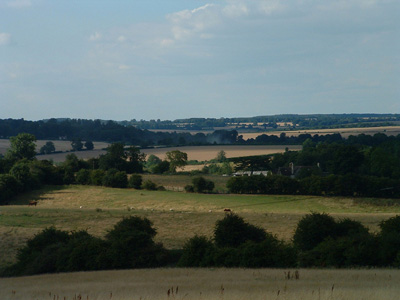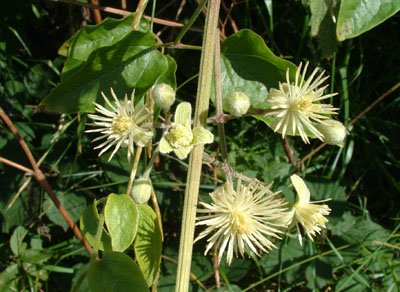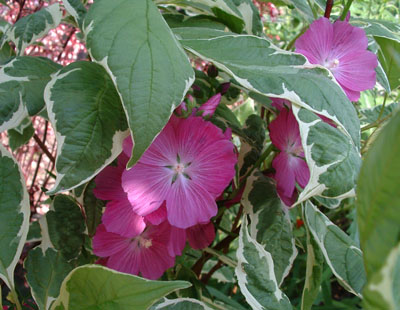August 11th 2005 - Oxfordshire and home
We had a few days away in Oxfordshire at the start of the month, staying with friends. Itís a lovely part of the country, with a very different landscape to North Lincolnshireís, where almost everywhere is flat. Oxfordshire rolls most beautifully, the low hills quilted with fields and dotted with farms and woodland. Itís the quintessential, picture postcard landscape and it was mental images of this kind of land that made me so homesick when worked in the Far East for a few years. On a day of almost unbearable heat and humidity, Iíd gone into a bookshop where Iíd seen a picture book about England. The cover had photo of a landscape that could easily have been in Oxfordshire and it brought tears to my eyes.

Oxfordshire view
"Many of the lanes we walked along had hedgerows that were positively festooned with our native Clematis vitalba"
During our stay we had a couple of long rambling walks, taking in the countryside near the town of Witney. Itís noticeable that the soil is different by looking at the trees and wildflowers growing. There are far more oaks and fewer beeches. Oaks like a more acid soil and donít grow to such size here as they do in Oxfordshire, while here we have huge beech trees which grow well in our more sandy soil. Many of the lanes we walked along had hedgerows that were positively festooned with our native Clematis vitalba, usually known as Old Manís Beard. I hadnít seen it in full flower before and was pleased to find that it has a pleasant, though faint, scent.

Clematis vitalba
Stopping for a picnic on a grassy hillside, I took my customary solitary wander to see what was growing in the long grass. Wild marjoram mixed with scabious, and a short growing type of Centaurea cyanus, were being visited by many bees and butterflies. The pinks and purples combined very well with the buff colour of the dry grass I wondered if the marjoram was a sign of previous settlement as the hill side looked to all of us like it could have been part of an old earth work. Sited on that low hill and next to a small river, it would have made a good spot to set up home, but no trace of dwellings showed above the long grass.
"Back at the house, I talked to young Freddie about the very fine and healthy looking French beans heís growing..."
Back at the house, I talked to young Freddie about the very fine and healthy looking French beans heís growing in three large pots. Both he and his brother have already had some of the beans with meals, though many seem to be eaten raw straight from the plant. Heís smart and chatty and, after finding that he has a budding interest in plants and likes scented leaves, I promised to take him some bergamot (Mondarda didyma) the next time we visit.
They have the most pleasing scent of any plant that I know, light and instantly uplifting. Iíve often wondered if it was bergamot that Tolkien had in mind when, in The Lord of the Rings trilogy, he has Aragorn use the herb Athelas to heal those touched by the evil of Sauron. Tolkien writes of a sweet fresh scent that fills the room and lifts the spirits of all close by. I think Freddie, a most discerning 10-year old, will like it.
Returning home, we were greeted by a very overgrown lawn. It seemed to have grown about four inches in the time that we were away and it took Karl a good while to cut it as he had to go over some parts three times to get up all the clippings. At this time of year, lawn cutting is complicated by first having to search out the baby frogs so that they arenít killed by the lawn mower, and moving them to a spot far enough away so that they canít hop back into the grass before itís cut. We wear gloves to move them so they arenít harmed by the heat from our hands. They are beautiful and perfect, like little jewels, perhaps crafted from gold and tigerís eye.
"If I keep taking it out before it seeds, Iím not sure where all the new plants can be coming from..."
As Karl mowed, I went about deadheading and pulling up weeds. We have masses of Euphorbia peplus (Petty Spurge) and no matter how much of it I remove, there is always more growing. If I keep taking it out before it seeds, Iím not sure where all the new plants can be coming from as there seem to more with each passing year. Maybe the seed survives for a long time in the soil and germinates as the ground is disturbed Ė Iíll have to look in to that. It isnít a bad looking weed but it develops rust in this garden and that canít be a good thing. Thatís something else I want to find out Ė how many rusts are plant specific?
In the greenhouse were some cuttings taken from a Sidalcea malviflora plant. The plant was in the garden but an unidentified something had nibbled the roots and the leaves were starting to yellow, so I cut the healthiest looking stems, about a dozen in all, poked them into pots of damp compost and left them to get on with it, only keeping them shaded and making sure that they didnít dry out.
Much to my pleasure, all rooted and are growing well. I planted them out yesterday and am looking forward to more of the pretty pink flowers, like miniature Hollyhocks. Unlike Hollyhocks, Sidalceas donít seem to be prone to being affected by rust and theyíre also very popular with bees and butterflies. Standing amongst mixed herbaceous perennials theyíre a good addition, adding height (up to 1.2m) and colour and having a long flowering season.

Sidalcea malviflora peeking through Cornus foliage
Also in the greenhouse the Bolivian Rainbow chillies are coming on really well and weíve already taken quite a few to put in spicy dishes and on pizzas. We both think that theyíre hotter this year than last year. They certainly taste good and the plants are cropping heavily. There is a glut of sweet basil, too, and I think we have some pesto making coming up. When the first lot of basil seeds went in, they didnít seem to be very vigorous, so I started more off, then they all suddenly romped away and now we have enough to start an Italian restaurant.
© Copyright Miranda Hodgson 2005